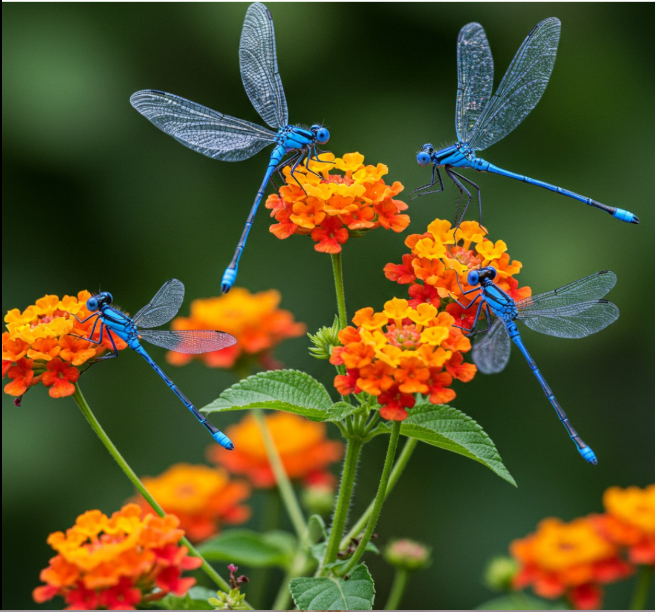These classic wildflowers bloom for months and serve as landing pads for dragonflies. They also attract small pollinating insects—easy prey for dragonflies. Plus, they’re easy to grow and reseed themselves year after year.
4. Swamp Milkweed (Asclepias incarnata)
🌞 Full Sun | Moist Soil
💗 Pink-to-white clusters of fragrant flowers.
This native milkweed variety loves moist spots—ideal around ponds. Dragonflies are drawn to its fragrance and abundant nectar. Bonus: it also supports monarch butterflies!
5. Yarrow (Achillea millefolium)
🌞 Full Sun | Drought-Tolerant | Poor Soils OK
🌸 Flat clusters in white, yellow, red, or pink.
With umbrella-shaped flowers that make perfect dragonfly rest stops, yarrow is also great for attracting other beneficial insects. It spreads easily, is deer-resistant, and thrives even in dry, tough soils.
6. Meadow Sage (Salvia pratensis)
🌞 Full Sun | Well-Drained Soil
🔵 Tall, spiky blooms in purple, blue, or pink.
Known for its lovely fragrance and long flowering season, meadow sage draws pollinators (and the insects dragonflies feed on). Its sturdy stalks also give dragonflies great visibility while perching.
7. Coneflower (Echinacea spp.)
🌞 Full Sun | Drought-Tolerant
🌺 Purple, pink, or white daisy-like flowers.
Coneflowers are insect magnets, which makes them perfect dragonfly lures. Their height and strong central cones offer ideal vantage points for hunting.
8. Goldenrod (Solidago spp.)
🌞 Full Sun | Well-Drained Soil
💛 Bright yellow late-summer blooms.
Often unfairly blamed for allergies (it’s not the culprit—ragweed is), goldenrod blooms when few others do, providing late-season nectar. Dragonflies linger longer in gardens with consistent insect activity into fall.
9. Lavender (Lavandula spp.)
🌞 Full Sun | Dry, Well-Drained Soil
💜 Fragrant spikes of purple flowers.
Lavender’s essential oils can repel mosquitoes, while its flowers attract pollinators and dragonflies. Dragonflies may not feed directly on lavender, but they love the bugs it brings in and the sunny perches.
10. Bee Balm (Monarda spp.)
🌞 Full Sun to Partial Shade | Moist Soil
🔴 Unique tubular blooms in red, pink, or purple.
A favorite among hummingbirds and dragonflies alike. The tubular blooms attract lots of flying insects, and its dense structure provides shelter. Bee balm also adds vibrant color and is great for wetter garden areas.
11. Liatris (Liatris spicata)
🌞 Full Sun | Moist, Well-Drained Soil
💜 Vertical purple or white flower spikes.
Dragonflies are drawn to tall, spiky plants for landing and hunting. Liatris blooms in mid-to-late summer, adding height, motion, and pollinator traffic that dragonflies enjoy hunting around.
12. Asters (Aster spp.)
🌞 Sun to Part Shade | Well-Drained Soil
🌸 Daisy-like blooms in shades of blue, pink, or purple (late-season).
These fall-blooming beauties keep your garden lively just when everything else starts to fade. They attract beneficial bugs and give dragonflies a final feast before winter.
🌿 Designing a Dragonfly-Friendly Garden
To truly attract dragonflies and keep them coming back:
✅ Include a Water Feature
- Even a half-barrel pond can work
- Add native aquatic plants like arrowhead or pickerel weed
- Avoid fish that eat dragonfly larvae
✅ Provide a Mix of Plant Types
- Choose plants that bloom from spring through fall
- Group flowers together—dragonflies spot mass plantings more easily
- Mix tall spikes (like liatris) with ground covers and clumps for diversity
✅ Create Perching Opportunities
- Dragonflies love bare twigs, long flower stems, and stakes
- Incorporate rocks, driftwood, or trellises for sunbathing and hunting posts
✅ Avoid Chemicals
- Skip insecticides, herbicides, and fungicides—these kill beneficial insects and dragonflies
- Embrace organic gardening techniques to support a natural ecosystem
🦋 More Benefits of Attracting Dragonflies
- Free mosquito control without harming pollinators
- Supports native biodiversity
- Encourages eco-friendly gardening
- Provides awe-inspiring nature encounters in your own backyard
You’ll also find fewer midges, gnats, and other annoying flying pests, as dragonflies are not picky eaters!
🌟 Final Thoughts: Natural Mosquito Control at Its Best
By planting a diverse array of nectar-rich, perching-friendly plants and providing a clean water source, you can transform your yard into a paradise for dragonflies. Not only will you enjoy fewer mosquito bites, but you’ll also be contributing to a healthier, more balanced ecosystem.
So ditch the sprays and zappers, and let dragonflies do what they do best—protect your space with style, grace, and a powerful appetite for pests. 🦟
ChatGPT a dit :
🦋




